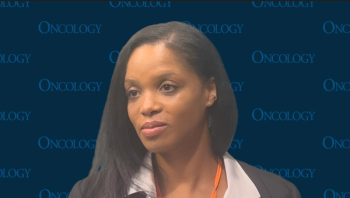
Zanzalitinib exhibited favorable data when evaluated alone or in combination with anti-PD-1 immune checkpoint inhibition in phase 1 RCC trials.

Your AI-Trained Oncology Knowledge Connection!


Zanzalitinib exhibited favorable data when evaluated alone or in combination with anti-PD-1 immune checkpoint inhibition in phase 1 RCC trials.
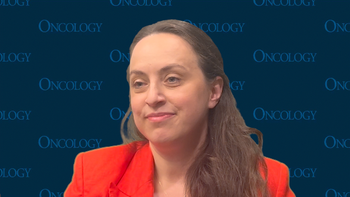
The investigational agent exhibited superior efficacy vs pembrolizumab in patients with lung cancer, suggesting potential efficacy in kidney cancer.
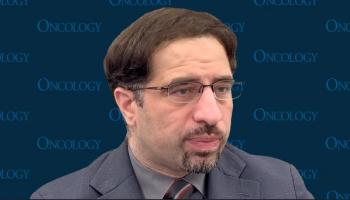
Management of adverse effects and access to cellular therapies among community oncologists represented key points of discussion in multiple myeloma.

Panelists discuss how a patient with multiple myeloma initially experienced severe fatigue, hair loss, swelling from kidney dysfunction, and overwhelming pain before being misdiagnosed with lupus, ultimately requiring emergency care where blood work and bone marrow biopsy confirmed both multiple myeloma and amyloidosis, leading to successful treatment with chemotherapy followed by stem cell transplant that achieved 5.5 years of remission monitored through regular blood draws tracking light chain levels.

Panelists discuss how multiple myeloma is a rare blood cancer affecting plasma cells that have gone rogue, causing symptoms like fatigue, kidney dysfunction, and bone pain, with approximately 36,000 new cases diagnosed annually in the US, primarily affecting older patients around 60 to 65 years of age. Although multiple myeloma is highly treatable with great therapy options available, the disease often relapses and requires aggressive early treatment approaches, including emerging immunotherapies that may help cure a larger fraction of patients in the future.
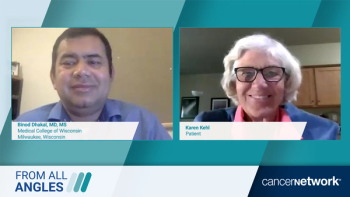
Panelists discuss how bispecific antibodies like talquetamab work through dual targeting mechanisms that bring T-cells and cancer cells together for tumor destruction, with patient Karen sharing her decision-making process based on treatment convenience, manageable adverse effects like taste loss and nail changes, and the therapy's effectiveness after initial severe reactions during step-up dosing.

Panelists discuss how multiple myeloma patients navigate complex treatment journeys through multiple relapses, clinical trials, and the transformative potential of bispecific antibody therapies like talquetamab, with patient Karen Kehl sharing her 15-year experience from initial diagnosis through 19 treatment cycles including three transplants and various clinical trials.
![“As a community, if we’re looking to help enroll and advocate for patients with rare [kidney cancers], we need to be aware of what is out there,” said A. Ari Hakimi, MD.](https://cdn.sanity.io/images/0vv8moc6/cancernetwork/a69f69efca1ade2e100fbb9cdf798d49ea5a0f94-2966x1684.png?w=350&fit=crop&auto=format)
“As a community, if we’re looking to help enroll and advocate for patients with rare [kidney cancers], we need to be aware of what is out there,” said A. Ari Hakimi, MD.

Treatment with the dual inhibitor displayed a short half-life and a manageable toxicity profile in patients with clear cell renal cell carcinoma.
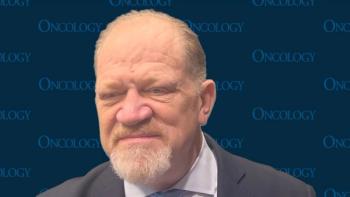
The annual Kidney Cancer Research Summit was born from congressional funding for kidney cancer research, according to KidneyCAN president Bryan Lewis.
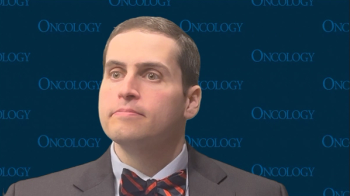
Combining renal vaccines with immune therapy may better target tumor cells while limiting harm to healthy tissue, according to David A. Braun, MD, PhD.
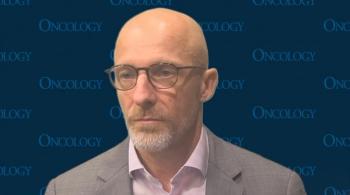
Improving data collection and biomarker development across institutions may represent areas of expansion in kidney cancer research.

KIM-1 is a biomarker in the blood that may help noninvasively detect kidney cancer, according to Wenxin (Vincent) Xu, MD.
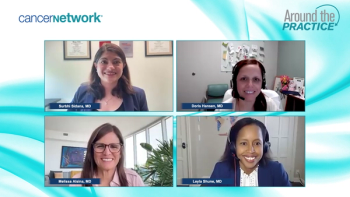
Panelists discuss the growing importance of early integration and collaboration between community oncologists and specialized centers in the evolving chimeric antigen receptor (CAR) T-cell therapy landscape for multiple myeloma, emphasizing timely referrals, coordinated care, and strategic sequencing with other immunotherapies to optimize patient outcomes.

Panelists discuss the essential role of supportive care following chimeric antigen receptor (CAR) T-cell therapy in multiple myeloma, emphasizing infection prevention through prophylaxis, immunoglobulin replacement, and vaccination strategies, along with the importance of coordinated long-term management between CAR T centers and community oncologists to ensure sustained survivorship care.

A phase 0 trial is seeking to assess the feasibility of aiding anticancer cells with cytokines to restore their function.

Although pembrolizumab addressed a long-standing need in adjuvant kidney cancer treatment, combinations with the agent may further bolster efficacy.
![“The trial will be successful, or [we’ll] declare it a success if we see at least 3 of 24 responses overall,” stated Ravi, MD, BChir, MRCP, on the phase 2 LASER trial in RCC.](https://cdn.sanity.io/images/0vv8moc6/cancernetwork/9addaac21d809a7b642a567b0a704cbb15d87ac5-2966x1684.png?w=350&fit=crop&auto=format)
“The trial will be successful, or [we’ll] declare it a success if we see at least 3 of 24 responses overall,” stated Praful Ravi, MB, BChir, MRCP, on the phase 2 LASER trial in RCC.
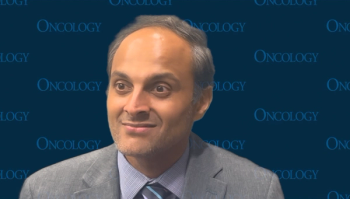
Success with the 177Lu-PSMA-617 radioligand therapy would be transformative for the clear cell renal cell carcinoma treatment landscape.
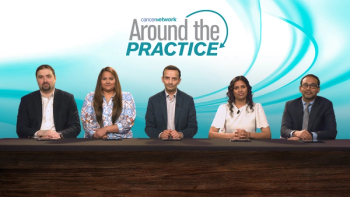
Panelists discuss how the extended follow-up data from MonumenTAL-1 show consistent safety outcomes for talquetamab with manageable discontinuation rates due to skin changes and weight loss, while acknowledging that GPRC5D targeting creates unique toxicities including nail and skin changes that require proactive management strategies, particularly as treatment transitions from academic centers to community practice where quality-of-life considerations become increasingly important.
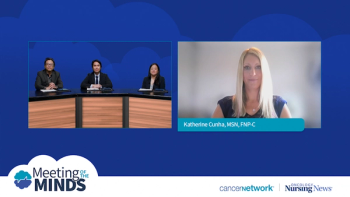
Panelists discuss how treatment selection between lorlatinib and alectinib for ALK-positive non–small cell lung cancer should consider both efficacy data favoring lorlatinib and patient-specific factors like neuropsychiatric history or cardiovascular comorbidities that might favor alectinib.
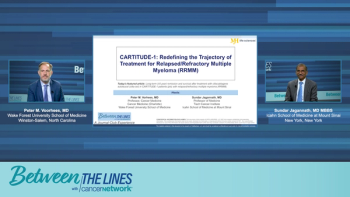
Panelists discuss how extended follow-up from CARTITUDE-1 shows continued overall survival benefit with minimal new safety concerns, reinforcing the durability and safety of cell therapy.
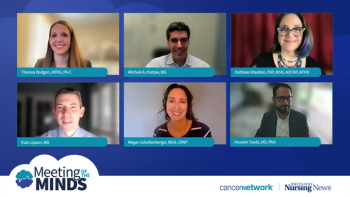
Panelists discuss real-world evidence comparing immunotherapy combinations for metastatic melanoma, highlighting retrospective analyses showing similar efficacy between nivolumab plus relatlimab and nivolumab plus ipilimumab, while emphasizing the relatlimab-based regimen’s lower toxicity and the need for individualized treatment decisions in patients who fall outside typical clinical trial populations.
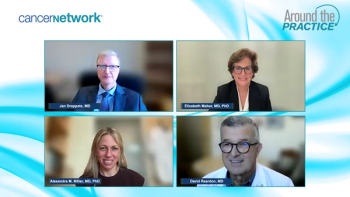
Panelists discuss how they approach the treatment journey by prioritizing early IDH mutation detection, coordinating multidisciplinary teams for maximal safe resection, and utilizing advanced surgical techniques to optimize outcomes while preserving neurologic function.

Panelists discuss how the 2021 WHO classification has fundamentally shifted glioma diagnosis from histologic appearance to molecular markers, particularly IDH mutation status, which now determines treatment strategies and prognosis.

Panelists discuss how a 48-year-old fitness instructor with ALK-rearranged stage IV lung cancer and bone metastases was successfully treated with alectinib, experiencing manageable adverse effects while returning to modified teaching activities.

Panelists discuss how some patients in CARTITUDE-1 maintained stringent complete remission for more than 5 years without further treatment, potentially redefining the concept of cure in myeloma.

Panelists discuss the prioritization of immunotherapy over targeted therapy for BRAF-mutant metastatic melanoma, highlighting updated RELATIVITY-047 data supporting nivolumab plus relatlimab for its durable efficacy and favorable toxicity profile, and emphasizing the importance of individualized treatment selection based on evolving evidence, patient goals, and comparative analyses of combination regimens.

Panelists discuss how the OPTEC trial and other studies demonstrate that outpatient teclistamab administration with prophylactic tocilizumab is feasible and safe, with no cytokine release syndrome (CRS) events reported in community settings, while acknowledging that Risk Evaluation and Mitigation Strategies (REMS) requirements remain a significant barrier to broader community adoption despite the reality that most CRS is now grade 1-2 and manageable with supportive care, suggesting the field needs to follow lymphoma’s example of bispecifics without REMS restrictions.
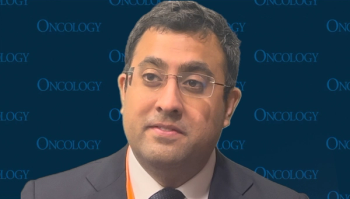
An ongoing phase 1 trial seeks to prove XmAb819 as an effective treatment and ENPP3 as a plausible target in patients with relapsed or refractory RCC.